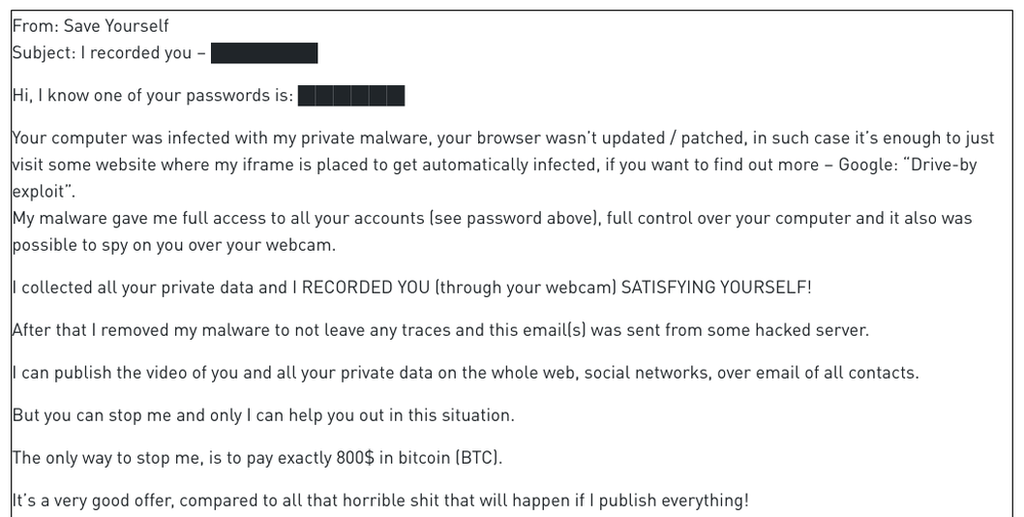

- #Apple ransomware porn how to
- #Apple ransomware porn install
- #Apple ransomware porn software
- #Apple ransomware porn free
- #Apple ransomware porn mac
#Apple ransomware porn mac
Mac and Windows owners may find this rule a bit tougher to follow, due to the plethora of app sources available on the web, but at the very least, be sure of the websites you’re downloading from.Īlways make sure you show file extensions on your computer. If possible, restrict app downloads to those from known sources, such as the Windows Store, the Mac App Store, the iOS App Store, and Google Play.
#Apple ransomware porn install
Never install an application on your computer or mobile device unless you’re absolutely certain of the source of the app.
#Apple ransomware porn free
(Like my doctor, Vinnie Boombotz says, “If you break your arm in three places, stay out of those places!”) Sure, the lure of free movies and music can be enticing, but think before you click. When browsing the web, use common sense and stay out of the darker corners of the web. Never click a link found in an email, even if it appears to be from someone you know. When I say that, I mean that you should always think twice about opening emails or email attachments from unknown parties. We’ll look at how “smart computing,” keeping your computer and other connected devices updated, and running anti-virus and anti-malware apps can help you keep your system running clean and green, keeping your personal or business data from possibly being lost forever. There are several ways to protect yourself from ransomware, and we’ll take a look at each one in this section. Tom’s Guide notes amounts have been reported to be in the range of $300 to $700 for victims in the United States, although amounts can vary according to the victim’s location. The amount of money demanded from individuals can be a substantial amount, but not financially crippling for the individual. No matter the type of ransomware, the goal of the evil payload is almost always to extort a payment of some sort from the victim. (One user turned himself in after a malware app threatened to call the authorities about child pornography on his hard drive. Once downloaded to your computer, the program then runs, locking the system, encrypting data, or, in some cases, even making threats that appear to come from a law enforcement agency. While operating system and networking companies regularly release updates to fix security flaws used by such trojan apps, many users fail to install the updates, leaving their machines and networks open to attack. Ransomware attacks are usually launched via a “trojan” application, which enters a system through a downloaded file or a security vulnerability in a network service. While some simple forms of ransomware can be easily decrypted by a knowledgeable user, more advanced methods of encryption make it nearly impossible to retrieve the encrypted files without the private key needed to perform the task. The victim is then told to pay a “ransom” to have the files unlocked so they can be accessed once again.
#Apple ransomware porn software
Ransomware is malicious software that encrypts or otherwise blocks access to the data stored on a user’s computer or mobile device.

In this article, we’ll take a look at how ransomware can hold your computing device and its files hostage, how you can prevent ransomware from attacking your computer, and what you can do if you find that your data is being held hostage. (Um, they’re “bad guys,” DUH!) However, most ransom payments have proven to result in the needed key to unlock files, as the scheme depends on victims believing that payment of the demanded sum will result in the freeing of their data.

Of course, payment of the ransom didn’t always result in the bad guys holding up their end of the deal. This type of ransomware demands a ransom be paid, upon which the user would receive a private key to decrypt their files. Late 2013 saw the rise of “crypto-ransomware” that encrypted a user’s files, ensuring the need to pay a ransom even if the ransomware itself was removed from the computer. The rise of cryptocurrency in recent years has also contributed to the rise of ransomware, due to the ability to receive the demanded ransom via Bitcoin and other anonymous forms of payment. In 2011, Trend Micro reported about an SMS ransomware strain that repeatedly displayed a ransomware page to users until they paid the ransom by dialing a premium SMS number.īy early 2012, ransomware began to spread outside of Russia, as the bad guys began to realize what a profitable business model it could be if performed properly.
#Apple ransomware porn how to
Also created on the drive was a “ransom note” text file, telling how to make a payment to get the files restored. Cases of ransomware were first seen in Russia in 2005.Ī 2006 report from Trend Micro told of an early ransomware strain that affected Windows computers, which would search a hard drive for certain files, zipping them into a password-protected file, deleting the original files.

R ansomware has been around for a while now and grows more prevalent with each passing year.


 0 kommentar(er)
0 kommentar(er)
